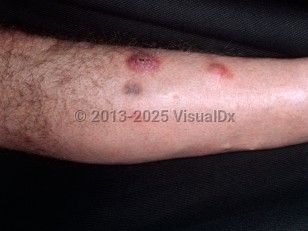Mycobacterium chelonae infection
Alerts and Notices
Important News & Links
Synopsis

Mycobacterium chelonae is an atypical, rapidly growing mycobacterial organism that causes skin infections in immunocompetent patients. Infection typically follows trauma such as tattooing, piercing, surgery, liposuction, or subcutaneous injections. The skin lesions range from grouped red papules and nodules to disseminated cutaneous abscesses that may follow a linear or sporotrichoid distribution in immunosuppressed patients. Lesions tend to be painful and slow-growing and may heal spontaneously. Most cases are restricted to the skin but can spread to underlying soft tissue and bone. Pulmonary disease and disseminated disease occur rarely. Mycobacterium chelonae infections are uncommon, and most have been reported in young men, but true sex and age predilection are unknown.
Codes
ICD10CM:
A31.1 – Cutaneous mycobacterial infection
SNOMEDCT:
402981007 – Mycobacterium chelonae infection of skin (disorder)
A31.1 – Cutaneous mycobacterial infection
SNOMEDCT:
402981007 – Mycobacterium chelonae infection of skin (disorder)
Look For
Subscription Required
Diagnostic Pearls
Subscription Required
Differential Diagnosis & Pitfalls

To perform a comparison, select diagnoses from the classic differential
Subscription Required
Best Tests
Subscription Required
Management Pearls
Subscription Required
Therapy
Subscription Required
References
Subscription Required
Last Updated:06/19/2014
Mycobacterium chelonae infection

